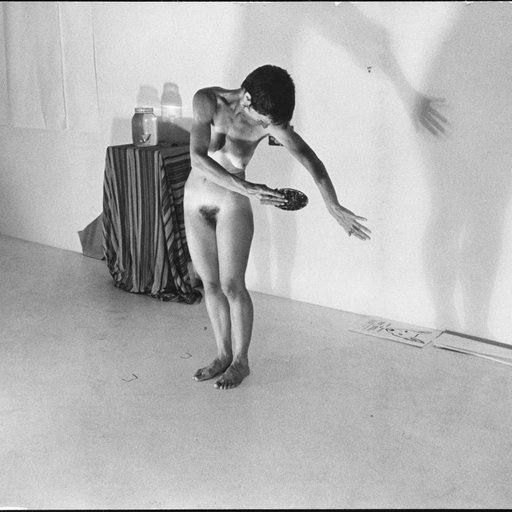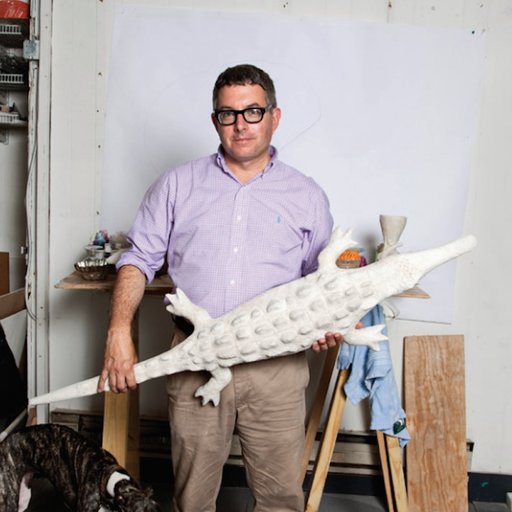The interdisciplinary artist Sanford Biggers is no fan of limitations (see his "Rules of the Game" below), yet his arresting, often performative installations, sculptures, and videos demonstrate a honed aesthetic restraint, cultivated in part by his ongoing engagement with Japanese Buddhist philosophy. The Angeleno-turned-New-Yorker does not shy away from confronting the continuing history of American racism, using music and strong symbolism as potent tools toward this end. Here, Biggers gives his best advice for surviving in the art world, excerpted in its entirety from the new book AKADEMIE X: Lesson in Art + Life.
In all honesty, I was a horrible student! In class, I was usually immersed in drawing and doodling on my, or other peoples’, notebooks, textbooks, and clothes, or I was distracted in some other way. It got so bad that I even had to collect daily progress reports from some classes. They have meds for that kind of stuff now, for better or worse, but back in the day, I was a ‘troubled student’. Somehow, I was able to make it through my early education to a liberal arts college, where I finished (doing quite well, surprisingly) before leaving the USA for a few years. Upon returning, I worked in a few different fields, gained no general life traction, and decided to go to grad school for a formal art education. That was where I began to understand what a studio really was and how I functioned most naturally as an artist.
I moved to New York after I graduated to further my education in the School of Hard Knocks (class of TBD), and have since taught at Cooper Union, Virginia Commonwealth University, Harvard University, and Columbia University. This is particularly ironic considering my spotty scholastic past. Though I still consider myself a student of sorts, as any good teacher should, I have learned a few solid lessons along the way.
BEING A VAMPIRE SUCKS
I am NOT a morning person. In grad school, I quickly learned this. Oh, how I admired the painters with their morning coffee and talk radio, painting when the sunlight was best, finishing when it got dark and leaving to meet friends for dinner or have a drink and get home at a reasonable civilized hour. But I preferred to work the night shift, often arriving at my studio at eight in the evening and working into the early morning. I had several preconceived notions about how a studio practice should be, and only pulling all-nighters was simply not one of them. It took me years to stop berating myself and finally accept my nocturnal self. Creativity is an organic and whimsical entity and it’s essential that every artist decide what works naturally and own it. Anything else is counterproductive.
THERE WOULD BE NO ART WORLD WITHOUT … WELL, THE ART
Artists all too frequently embrace a stance of passivity when dealing with collectors, galleries, writers, curators, etc. Know your worth, personally and professionally, and remember that there would be no art world without the art. Acknowledge the power of your production and approach your professional relationships as a valuable partner, not an employee.
IF YOU WANT A NORMAL LIFE, GET A NORMAL JOB
Chances are that you will not spend every day sitting in outdoor cafés smoking Gauloises, wearing a beret, sipping espresso, and riding off on your Vespa. You will, however, work so hard and long that your friends and relatives will have to send out search parties for you. Understand now that to be an artist means: You will occasionally say "Sleep? Oh yeah, I remember that." You will work the shittiest job, live and create in the shittiest places, and socialize with some of the shittiest people in order to make your work. You will miss so many social or fun events that you’ll make monks looks like party animals (hey, at least they get fed)! You will become good friends with #FOMO. You will and must embrace your inner mania! This last point is particularly important since it is what will keep you on task in spite of the obstacles you will face.
THIS IS A MARATHON, NOT A SPRINT
To succeed and survive as an artist, one must develop serious perseverance, strength of character, an unshakable work ethic, and confidence. Artistic trends, attitudes, and appreciation change frequently, so you must be able to see beyond the successes and failures you may experience. Understanding where you are in relationship to other artists is useful; however, do not allow it to turn into envy or self-doubt. When I was beginning I was advised by a mentor: "Only be an artist for the love of art and the act of creation. Nothing else is promised." Accolades, fame and fortune may come and go, and that’s only if you’re lucky.
PATRONS
True patrons do exist, as do moonbows (look ’em up). But until you find one, realize that the fellow artists in your network are already your best and most loyal patrons. You will introduce each other to curators, writers, collectors, and other artists, etc., help each other find studios, residencies, and jobs, assist each other in production, and give each other the best critiques you could ask for. To reiterate a previous point, artists do not need to wait on the generosity of others. Harness your own power and agency and utilize your already abundant resources.
THE DAYS OF THE ARTIST AS SAVANT/NAÏF ARE SOOO NINETEENTH CENTURY
Let’s face it, many of us are as educated and diversely experienced as the people promoting, selling, and buying our work. There is really no good excuse for not being the most knowledgeable and articulate spokesperson for your own work. Practice writing and speaking about what you do, and read other artists’ writings as well. There will be a time when you are called upon to express your thoughts, and though you can often decide when or when not to do this, you don’t want to sound like a dumbass when you do engage.
RULES OF THE GAME
Fuck rules!
ASSIGNED READING AND LISTENING
Reading:
– Diop, Cheikh Anta. Nations Nègres et Culture. Paris: Présence Africaine, 1955
– Diop, Cheikh Anta. Antériorité des civilisations nègres: mythe ou vérité historique? Paris: Présence Africaine, 1967. Translated by Mercer Cook as The African Origins of Western Civilization: Myth or Reality. Chicago: Lawrence Hill & Co., 1974.
Both of these were seminal to my desire to ‘re-right’ history in my work, albeit through abstract and associative means. Diop’s refutation of the Eurocentric biases of academic research and accounts of the history of civilization led to vilification by the majority of his colleagues. Throughout subsequent decades, however, many of his assertions have been proven correct.
My take away:
a) Your life’s work may never be fully appreciated in your own lifetime. Not that I romanticize this notion, but it helps to understand that it’s an occupational hazard in our field.
b) History is part research, part conjecture, or, you just can’t believe everything you read.
– Hickey, Dave. Air Guitar. Los Angeles: Art Issues Press, 1997.
Though written a little over fifteen years ago, Air Guitar still resonates for me. What can I say? I’m a fan of high/low simultaneity, disparate and scattered influences, and a general disdain for the prescriptive, prepackaged, and pre-approved nature of certain sectors of today’s artistic terrain.
– Tanizaki, Junichiro. In Praise of Shadows. Sedgwick, ME: Leete’s Island Books, 1977. Translated by Thomas J. Harper and Edward G. Seidensticker. First published in Japanese, 1933.
I read this while living in Japan and found that it gave me a deeper insight into aspects of Japanese aesthetic philosophy. Positing the oppositional forces of light and dark, Tanizaki praises the subtle world of shadows and understatement in Japanese aesthetics against the brash and shiny newness of Western ‘progress’.
Listening:
– The Miles Davis Quintet. The Complete Studio Recordings of The Miles Davis Quintet 1965–1968. Columbia, 1998
This first grouping is from Miles Davis’ second great quintet with the young lions Tony Williams, Ron Carter, Wayne Shorter and Herbie Hancock. He had won international acclaim with Kind of Blue and Sketches of Spain and entered into his free-jazz phase. At this point, he discarded the traditional bandleader/band relationship and let all of the musicians form the music organically.
– Miles Davis. Dark Magus. CBS-Sony, 1977.
Davis’ path is essential because it’s a journey from his apprenticeship under Bird and Diz, to his breakthrough moments and successes with ‘hard bop’, ‘cool’, and ‘modal’ jazz (Kind of Blue, etc.), to his deconstruction of his own practice and forays into electric instrumentation, rock-editing techniques, and funk, much to the chagrin and distaste of his fans and critics. Dark Magus is a fully improvised concert at Carnegie Hall, dangerously featuring two musicians who’d never even played with his band before that evening! Davis lived and created on the razor’s edge and never rested on his laurels.
READ MORE FROM AKADEMIE X ON ARTSPACE:
6 Art-World Lessons From the Unorthodox Classroom of Akademie X
Chris Kraus on the Ambiguous Virtues of Art School
Go On a New York City Scavenger Hunt With Artist Mark Dion
Words to Live By: Marina Abramović's Mystical Maxims for Artists
Venice Biennale Representative Joan Jonas's Workout Regimen for Artists
The Four-Hour Art Week? Read Carol Bove's Self-Help Guide for Artists
























